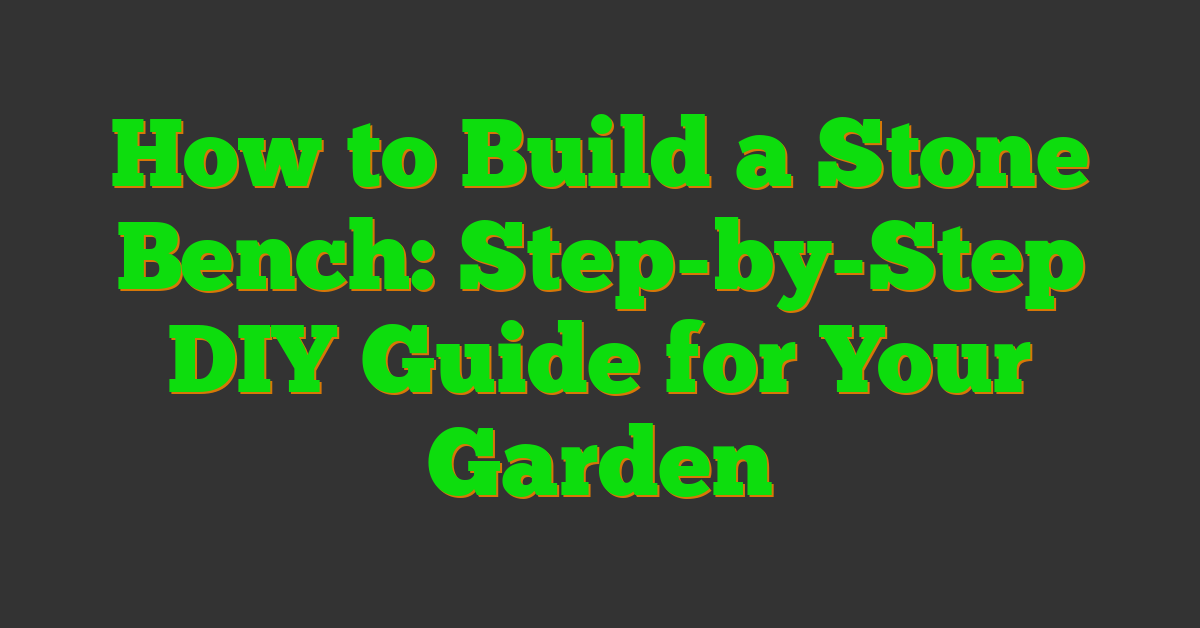Creating your own stone bench is a rewarding project that combines functionality with natural beauty. I’ve always loved the idea of having a sturdy, handcrafted piece in my garden where I can relax and enjoy the outdoors. Building a stone bench might seem daunting at first, but with the right guidance, it’s entirely achievable.

In this guide, I’ll walk you through each step of the process, from selecting the perfect stones to assembling your bench with confidence. Whether you’re a seasoned DIY enthusiast or just starting out, you’ll find the tips and tricks you need to craft a beautiful stone bench that lasts for years to come. Let’s dive in and transform your outdoor space with your very own handmade stone bench.
Materials Needed
| Material | Quantity / Description |
|---|---|
| Stone Blocks | 20–30 flat stones for the seating surface |
| Mortar | One 80-pound bag for binding stones together |
| Gravel | 2 cubic feet for the base layer |
| Sand | 1 cubic foot to level the gravel |
| Wooden Forms | Several 2×4 lumber pieces for shaping the bench |
| Concrete Blocks | Optional blocks for added stability |
| Tools | Level, trowel, mortar mixing bucket, gloves |
Tools Required
| Tool | Purpose |
|---|---|
| Level | Ensures the bench is even and stable. |
| Trowel | Applies mortar to bind the stones. |
| Mortar Mixing Bucket | Mixes mortar to the right consistency. |
| Gloves | Protects hands during construction. |
| Shovel | Moves gravel and sand for the base. |
| Rubber Mallet | Adjusts stones without damaging them. |
| Measuring Tape | Measures dimensions accurately. |
| Wheelbarrow | Transports materials around the site. |
Planning and Designing
I start by carefully planning and designing my stone bench to ensure it fits perfectly in my outdoor space and matches my style.
Measuring and Sizing
Accurate measurements ensure a stable and comfortable bench. I measure the available area, deciding on dimensions that suit my garden. Typically, a bench measures 48 inches long, 18 inches deep, and 18 inches high. Adjusting these sizes accommodates personal comfort and the number of users. I also account for the height of surrounding elements to ensure a seamless fit.
Choosing a Style
Selecting a style reflects my garden’s overall look. I choose between traditional, rustic, or modern designs based on my outdoor theme. Traditional benches feature symmetrical shapes and classic details, while rustic styles embrace natural stone textures and irregular forms. Modern designs incorporate clean lines and minimalistic elements. This choice influences the type of stones and construction techniques I use, ensuring the bench complements my outdoor environment.
Preparing the Site
I start by preparing the site to ensure a solid foundation for the stone bench.
Clearing the Area
First, I clear a 4×6 foot area, removing grass, roots, and debris. Using a shovel, I excavate the site to a depth of 6 inches. This space accommodates the base materials and prevents future settling.
Setting the Base
Next, I set the base with gravel and sand for stability. I distribute 2 cubic feet of gravel evenly across the cleared area. Then, I add 1 cubic foot of sand, leveling it with a rake. This foundation supports the bench and allows proper drainage.
| Base Material | Quantity |
|---|---|
| Gravel | 2 cubic feet |
| Sand | 1 cubic foot |
Selecting and Preparing Stones
Choosing the right stones ensures durability and aesthetic appeal for your stone bench. Proper preparation is essential for a stable and attractive final product.
Types of Stones
Selecting the appropriate stone type affects both the bench’s appearance and longevity. Common choices include:
- Granite: Durable, resistant to weather, available in various colors.
- Slate: Smooth surface, excellent for seating, comes in neutral tones.
- Limestone: Soft texture, easy to shape, ideal for intricate designs.
- Sandstone: Natural hues, textured finish, suitable for rustic styles.
- Marble: Elegant appearance, may require more maintenance, limited color options.
Cutting and Shaping
Preparing stones involves precise cutting and shaping for a perfect fit. Follow these steps:
- Measure each stone to match bench dimensions.
- Mark cutting lines using a chalk line or marker.
- Use a stone saw or angle grinder with a diamond blade for accurate cuts.
- Smooth edges with a rubbing stone or sandpaper to prevent splinters.
- Test fit each stone, adjusting as necessary for a secure assembly.
Proper cutting and shaping ensure that each stone fits seamlessly, providing a sturdy and comfortable seating surface.
Laying the Foundation
Creating a strong foundation ensures your stone bench stands the test of time.
Building a Stable Base
I begin by spreading 2 cubic feet of gravel evenly over the cleared area. Next, I add 1 cubic foot of sand on top, using a shovel to distribute it uniformly. Compacting the sand with a tamper secures the base, providing both drainage and stability. This layered approach prevents shifting and supports the weight of the stone bench effectively.
Ensuring Level Surfaces
Using a level, I check the sand surface for flatness. If any areas are uneven, I add or remove sand accordingly. It’s crucial the base is perfectly level to ensure the bench sits evenly. I double-check the level in multiple spots, making adjustments as needed. A level foundation guarantees a comfortable and secure seating area.
Assembling the Bench
With all materials ready, I begin assembling the stone bench by stacking and securing the stones.
Stacking the Stones
- Arrange the Base Layer: I place the largest stones first, ensuring they are evenly spaced within the 48-inch length.
- Build Upward: I add subsequent layers, alternating stone sizes for stability and aesthetic appeal.
- Check Alignment: After each layer, I use a level to confirm the bench remains even and balanced.
- Maintain Consistency: I keep the seating surface smooth by selecting flat stones and adjusting as needed.
Securing the Structure
- Apply Mortar: I spread a thin layer of mortar between each stone, ensuring a strong bond.
- Press Stones Firmly: I press each stone into the mortar, removing excess to maintain a clean look.
- Reinforce with Wooden Forms: If using wooden forms, I secure them to hold the stones in place until the mortar dries.
- Allow to Cure: I let the mortar set for at least 24 hours, ensuring the bench remains sturdy and durable.
Finishing Touches
Once the stone bench is assembled, it’s time to enhance its comfort and durability with some final steps.
Adding Seating Comfort
To make the bench more comfortable, I add cushions or outdoor pillows. Choosing weather-resistant fabrics ensures longevity. For example, I select cushions filled with foam for support and UV-resistant covers to prevent fading. Additionally, incorporating non-slip pads beneath the cushions keeps them in place, providing a stable and cozy seating experience.
Sealing and Protecting
Sealing the stone bench protects it from the elements. Applying a high-quality masonry sealant helps prevent water damage and staining. I choose sealants appropriate for the stone type used, such as granite or limestone. If I encounter harsh weather conditions, I apply an extra coat to enhance protection. Regular maintenance, like reapplying sealant every few years, ensures the bench remains sturdy and retains its natural beauty.
« Regional Plant Guide: New York Edition – Comprehensive Resource for Thriving Gardens Regional Plant Guide: Colorado Edition – Explore 100+ Native Species »
Maintenance Tips
Maintaining your stone bench ensures it remains beautiful and functional for years. Here are key tips to keep it in top condition:
Regular Cleaning
I clean my stone bench regularly to prevent dirt buildup. Using a soft brush and mild soap, I remove debris and stains. For tough spots, a mixture of water and vinegar works effectively.
Sealing the Stone
Sealing protects the bench from moisture and stains. Every two years, I apply a high-quality masonry sealant. This step minimizes water damage and preserves the stone’s natural color.
Inspecting for Damage
I inspect the bench quarterly for cracks or loose stones. Early detection allows me to address issues before they worsen. Tightening mortar joints and repositioning stones maintains stability.
Prompt Repairs
When I notice damage, I act quickly. Reapplying mortar to loose stones ensures the bench remains secure. For significant cracks, I consult a professional to restore the structure.
Protecting Against the Elements
To extend the bench’s lifespan, I use protective covers during harsh weather. Additionally, placing cushions on the seating area prevents wear and tear from constant use.
Managing Moss and Algae
In damp climates, moss and algae can thrive. I remove them using a mixture of bleach and water, applying it carefully to avoid damaging the stone. Regular treatment keeps the bench looking clean.
Preventing Staining
I place non-slip pads under cushions to prevent staining from moisture. Additionally, I avoid placing food or drinks directly on the bench to minimize spills and residue.
Seasonal Maintenance
Each season, I perform specific maintenance tasks. In spring, I check for winter damage and clean the bench thoroughly. In fall, I ensure proper sealing before the cold weather sets in.
By following these maintenance tips, I keep my stone bench in excellent shape, ensuring it remains a cherished part of my outdoor space.
Conclusion
Building a stone bench has been one of my favorite projects. Seeing it come together piece by piece was incredibly rewarding. I love relaxing on it now and enjoying the beauty it adds to my garden. If you give it a try you’ll find it’s a fulfilling way to create something unique for your outdoor space. Happy building!
















